Biodiversity protection guarantees BH Airport its fifth Green Airport seal
| Company | Belo Horizonte/Confins - Tancredo Neves International Airport |
|---|---|
| Date | 08.10.2025 |
For the fifth consecutive year, BH Airport has been recognized as a Green Airport by ACI-LAC (Airports Council International – Latin America & Caribbean). In the 2025 edition of Green Airport Recognition, the Fauna Passage project was recognized during the Airports Council International Annual Conference and Exhibition, held this Monday in Trinidad and Tobago.
 “By once again receiving the Green Airport seal, we demonstrate the importance of the ESG agenda for BH Airport, balanced with operational efficiency and the modernization of our infrastructure,” said Daniel Miranda, CEO of BH Airport. “We work both to minimize the impact of aviation on the environment and to provide solutions by creating an ecosystem for the protection and conservation of biodiversity, reinforcing our commitment to sustainable development,” he emphasized.
“By once again receiving the Green Airport seal, we demonstrate the importance of the ESG agenda for BH Airport, balanced with operational efficiency and the modernization of our infrastructure,” said Daniel Miranda, CEO of BH Airport. “We work both to minimize the impact of aviation on the environment and to provide solutions by creating an ecosystem for the protection and conservation of biodiversity, reinforcing our commitment to sustainable development,” he emphasized.
The Green Airport Recognition evaluation criteria consider the involvement of the airport’s senior management, demonstrating active participation and support; the sustainability benefits, supported by quantitative data and indicators that contribute to the United Nations Sustainable Development Goals; Stakeholder engagement, with evidence of collaboration with internal teams and external partners, as well as innovation.
The wildlife crossing was built by the Minas Gerais state government, under the responsibility of the Minas Gerais State Highway Department (DER-MG), before the concession to BH Airport began. “Today, we are responsible for maintaining and monitoring the wildlife at the site, protecting the region’s biodiversity, in synergy with the Lagoa Santa Karst Environmental Protection Area (APA Carste),” explains Daniel Miranda.
What is the wildlife crossing?
 It is a tunnel approximately 2 meters high and 60 meters long, built under the LMG 800 highway, the main access to BH Airport. The structure facilitates the safe movement of wild animals between two large forest fragments, forming an ecological corridor for wildlife in the Lagoa Santa Karst Environmental Protection Area, which is part of the airport site.
It is a tunnel approximately 2 meters high and 60 meters long, built under the LMG 800 highway, the main access to BH Airport. The structure facilitates the safe movement of wild animals between two large forest fragments, forming an ecological corridor for wildlife in the Lagoa Santa Karst Environmental Protection Area, which is part of the airport site.
Since 2023, several local fauna species have been recorded during the underground crossing, including wild mammals typical of the Atlantic Forest and Cerrado biomes, some classified as endangered or vulnerable to extinction. Nearly 20 species have already been identified traveling along the passage. Among them are lesser anteaters, brown brocket deer, tayras, hedgehogs, coatis, ocelots, bush dogs, ferrets, armadillos, opossums, capybaras, tapirs, bats, and pacas.
Monitoring is carried out by the BH Airport wildlife management team using camera traps that capture images and videos of the animals during the crossing. In addition to protecting local biodiversity and ensuring gene flow between native species, the crossing prevents accidents. In the first two years of monitoring, an approximately 83% reduction in wildlife roadkill along the highway was observed. The reports and data generated are made available by the airport to support research and scientific work within the Karst Environmental Protection Area (APA Karste).
Natural Heritage
The region surrounding BH Airport is home to over 300 hectares of native vegetation, distributed between the Atlantic Forest and Cerrado biomes, forming an ecosystem integrated with other preserved areas. The landscape is also notable for its geological, paleontological, archaeological, and hydrological diversity. The local karst system, characterized by soluble rocks in geology, presents a landscape characterized by caves, sinkholes, and underground aquifers, essential for biodiversity preservation and water supply.
The Karst Environmental Protection Area (APA Karste), where BH Airport is located, also features remains of extinct megafauna and prehistoric peoples, fundamental to understanding the natural and human history of the region and the American continent. The oldest human fossil in the Americas, named “Luzia,” was discovered within the protected area, located approximately 3 km from the airport runway. The revelation opened the way for a reevaluation of theories related to the origin and migration of the continent’s first inhabitants.
Contact
LMG-800 Km 7,9 s/n, Confins - MG, 33500-900, Brazil
Brazil
- +55 31 3689-2700

